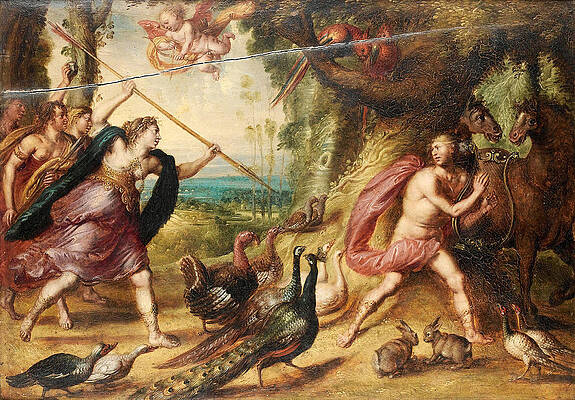Jan Thomas
Shepherd and Shepherdess
Jan Thomas or Jan Thomas van Ieperen (also Jan Thomas van Yperen) (5 February 1617 – 6 September 1673) was a Flemish Baroque painter, draughtsman and engraver active in Antwerp and at the Habsburg court in Vienna. He is known for his portraits of the rulers of Austria as well as for his pastoral, mythological and religious scenes.[1]
Life
Jan Thomas was born in Ypres, Flanders (hence his name 'van Ieperen', which means 'from Ypres') and died in Vienna.
Little is known about the artist's training. The 17th century Flemish biographer Cornelis de Bie wrote in his Het Gulden Cabinet that Jan Thomas was a student of Peter Paul Rubens. However, modern scholarship tends to regard Jan Thomas as one of the many collaborators in Rubens’ workshop who assisted with large commissions such as the decorations for the Torre de la Parada, the hunting lodge of the Spanish king (1636-1638).[2]
Shepherd and Shepherdess
Jan Thomas became a master in the Antwerp Guild of Saint Luke in 1639/1640. Two years later he acquired Antwerp citizenship. In 1641/1642 he took Andris Lamberechts on as an apprentice and the next year Andrias de Coninck and Jacob Sons joined his workshop as pupils. In 1642 he married Maria Cnobbaert, daughter of the Antwerp book dealer Jan Cnobbaert.[3] In 1652 Jan Thomas’ third child was baptized in the St. James' Church in Antwerp, which is evidence that he was then still living in that city.
It is believed that Jan Thomas left Antwerp in 1654 to work as a painter for the bishop of Mainz Johann Philipp von Schönborn one of the important courts at that time. Around 1658 he was in Frankfurt at the time of the coronation of Leopold I as emperor of the Holy Roman Empire and painted a (now lost) portrait of the emperor. In that period he also received commissions from the Archduke Leopold Wilhelm of Austria. From the latter part of the 1650s Jan Thomas certainly lived with his family in Vienna. In Vienna he received commissions from the imperial court and painted the portraits of Leopold I and his wife Margaret Theresa in theater costume. These portraits were made at the occasion of the celebrations surrounding the marriage of the imperial couple in 1666.[4]
Jan Thomas also received commissions from the higher clergy and the aristocracy, such as the House of Zrinski.[1] He painted a portrait of the general and poet Miklós Zrínyi just before his death in 1664.
Work
In addition to large religious history paintings, Jan Thomas painted landscapes with mythological or pastoral figures and portraits. He made a large number of portraits of Leopold William and Emperor Leopold I and other members of the royal and aristocratic families in the Habsburg territories.[4]
Leopold I as Acis in the play "La Galatea"
Infanta Margaret Theresa, Empress, in theater dress
His style shows a close relationship to the work of Rubens, in particular Rubens’ later work which was sent directly to Spain. This is evidence that he likely worked in Rubens’ workshop at the end of the master’s life and/or just after his death.[2] Like his contemporary Frans Wouters, many of his works translate the monumental Baroque style of Peter Paul Rubens into the small context of cabinet paintings.
The Triumph of Bacchus
Around 1658 Jan Thomas began to work in the new medium of the mezzotint. One of these works in mezzotint is a portrait of Titian from 1661, which was dedicated to Empress Eleonora, widow of the father of Leopold I, Emperor Ferdinand III. Besides engravings in mezzotint Jan Thomas also made etchings. He made engravings of his own compositions as well as of the works of other artists such as Rubens, Anthony van Dyck, Gerard Dou and Giovanni Ambrogio Figino.[5]
References
Hans Vlieghe. "Thomas, Jan." Grove Art Online. Oxford Art Online. Oxford University Press. Web. 4 October 2016
Arnout Balis, Rubens and his Studio: Defining the Problem, in: Joost vander Auwera, Rubens: A Genius at Work: the Works of Peter Paul Rubens in the Royal Museums of Fine Arts of Belgium Reconsidered, Lannoo Uitgeverij, 2007, p. 46
Jan Thomas at the Netherlands Institute for Art History (Dutch)
Hans Vlieghe, Flemish Art and Architecture, 1585-1700, Pelican history of art, New Haven: Yale University Press (1998): 111–112. ISBN 0-300-07038-1
J. van Tatenhove, Jan Thomas van Yperen, in: Delineavit et Sculpsit, No. 15, May 1995, p. 39-41
----
Fine Art Prints | Greeting Cards | Phone Cases | Lifestyle | Face Masks | Men's , Women' Apparel | Home Decor | jigsaw puzzles | Notebooks | Tapestries | ...
----
Artist
A - B - C - D - E - F - G - H - I - J - K - L - M -
N - O - P - Q - R - S - T - U - V - W - X - Y - Z
Retrieved from "http://en.wikipedia.org/"
All text is available under the terms of the GNU Free Documentation License




